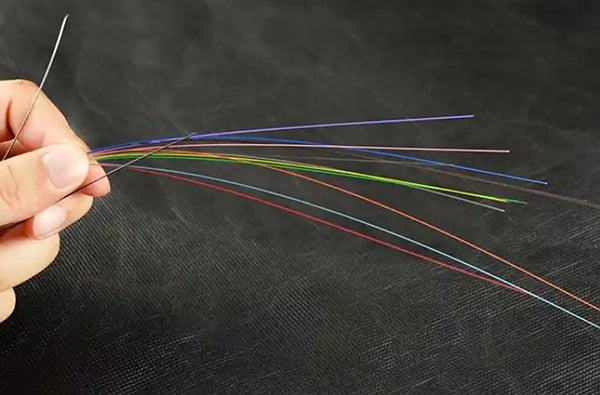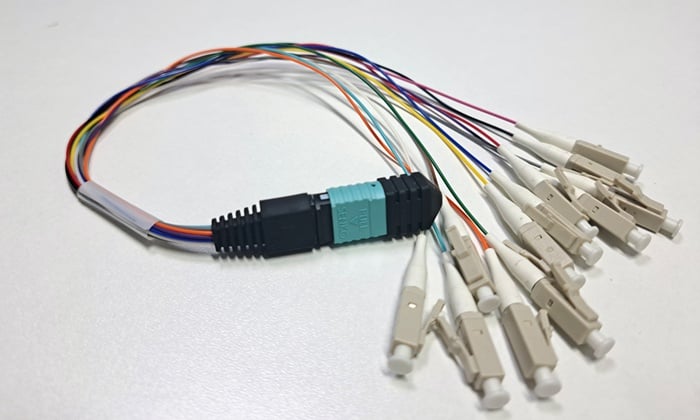Optical Networking
Fiber Color Code: A Simple Guide for Beginners (2024)
Initial Published: January 17, 2023
Although fiber optic cable is commonly part of optical networking, many technicians still need clarification with fiber color codes. In this guide, you’ll learn the standard color codes and how to identify them.
Table of contents
What is Fiber Color Code?
Fiber color code is a standard for quickly identifying fibers, cables, and connectors. The Telecommunications Industry Association (TIA) especially launched the TIA-598 standard. This standard addresses the manufacturer’s fiber color codes to follow and reference.
We can divide the color code into three categories for the different segments. Let’s look at them now.
Cable Jacket Color Code
Fiber optic cables for external plants and premises, such as fiber optic distribution cables and fiber optic patch cables, often use colored outer jackets or printing.
The EIA/TIA-598 standard defined the outer jacket color codes for the different fibers. Therefore, we can quickly identify fiber optic cables that contain only one cable type by color.
However, when the premises cable has more than one fiber type, the outer jacket should include a printed legend identifying the number and kind of fibers inside the cable. That will help the user specify the fiber count and type it quickly. For example, print “12 Fiber, 8 x 50/125, 4 x SM.” on the cable.

Inner Fiber Color Code
Inner fibers will also be color-labeled for easy identification within each cable or inside each tube in a loose tube cable.
Usually, there are two scenes based on the fiber number.
For cables with less than 12 strands of fibers, each fiber will be identified with 12 colors.

For cables with over 12 strands of fibers (such as 24 fibers), the color code runs from 1 through 12 and then repeats itself. But, identify each 12-strand group in a distinctive way, such as by adding a stripe to the second group (if it’s a 24-strand cable) or using another distinctive mark to distinguish the new group.


Connector Color Code
Now, let’s talk about the fiber color codes of optical connectors.
In general, we can use different color coding to help identify the type of connector used on a fiber optic patch cord. The standard multimode OM1/OM2 fiber patch cords are typically colored in beige or black, while OM3 and OM4 are aqua and magenta, respectively.
For single mode UPC, the standard is blue, while for single mode APC terminations, green fiber connectors are used. It is crucial to distinguish UPC and APC connectors because we cannot use them mixed.

APC connectors (color-coded green) have fiber end faces polished at an 8-degree angle; UPC connectors (color-coded blue) are polished and have no angle. With UPC connectors, any reflected light is directed toward the light source.
Further Reading
The Importance of Fiber Optic Color Codes
Using the correct fiber color code can help technicians efficiently manage and troubleshoot fiber optic cables. Network administrators can quickly identify fiber types and obtain the equipment information by looking at the fiber color code. That simplifies redundant inspections and reduces installation and maintenance time.
Especially in modern high-speed data centers, multi-core fiber optic and ribbon cable systems are commonly used. Each device may connect to tens or hundreds of fibers with different core counts. Therefore, identifying optical fibers in this high-density cabling scenario becomes extremely important. Effective fiber color management ensures efficient network operation, reduces downtime, and increases network reliability. In addition, it simplifies the process of network expansion and infrastructure upgrades.
FAQs
How do you remember the fiber color code?
Remembering many color codes may require confusion, but this method may help you remember them.
Let’s simplify the process by breaking down the color codes into four groups of 3 colors each. Combining the initials of these colors into a single word allows you to remember them easily, making remembering fiber color codes much more manageable.
For example, the first group color code acronym can be “BOG.” The second group color code acronym can be “OSW.” The third group can be “RBY.” The fourth group is “VRA.” In this way, we need to remember four simple words and translate them to specific colors when used.
Can I develop my color code system?
While developing your own color coding system is possible, adhering to established industry standards such as TIA-598 is paramount. This adherence is crucial in avoiding confusion and errors, especially when collaborating with other professionals or integrating with existing systems.
Final thoughts
Knowing the basics of fiber color code is essential for beginners. It helps us distinguish fiber types visually from the colored fiber optic jacket, inner fiber, and fiber connector. More importantly, mastering this knowledge can improve fiber cabling efficiency and minimize time spent.
Can you say the fiber cable is just through their color?
Do you think something is missing? Feel free to leave a comment!
Read more:
- Single Mode vs. Multimode Fiber, What is The Difference?
- Understanding CS Connector for Fiber Patch Cable: A Beginner Guide
- Understanding Armored Fiber Optic Cable: A Beginner Guide
- 16 Tips On How To Save Fiber Cabling Cost
- The Best Optcore Fiber Patch Cables for Home Network
- Fiber Connector Types: A Complete Guide
- OS1 vs OS2 Fiber, What is the Difference?
Reference:

 Español
Español Français
Français Deutsch
Deutsch





